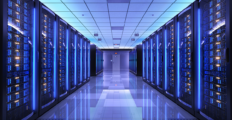
Almost all businesses use PCs for calculations, charts, graphs, and documents. Small firms only need a few laptops. When computers become 10, 20, or 30, you need a system administrator (technician). There are problems with data leakage or accidental deletion. Machines need periodical care for dust removal, thermal paste replacement, software update, and installation of additional programs.
In such a situation, one can’t help but wonder how to optimize it. As an option, you can use remote desktop technology. This article will discuss how remote desktop works, what are the advantages and disadvantages, and who is suitable for remote desktop.
Understanding Remote Desktop Technology
Remote desktop technology refers to a set of technologies and protocols that allow users to access and control a computer or a virtual desktop remotely from another device. It enables individuals or organizations to interact with a remote system as if they were physically present in front of it.
Virtual machines are created on the physical server. They have equal computing power, regardless of the characteristics of the devices from which the connection is made. The latter act as monitors and implement the input and output interface. All data are stored on the server. Employees have access to their desktop in the cloud in the form of a login and password. It is possible to connect from anywhere in the world.
The most commonly used protocol is RDP (remote desktop protocol), developed by Microsoft. It has been in use since 1998 and is still in use today, including Windows 11/22 Server. There are variations for all operating systems: Linux, Android, macOS, etc.
The RDP protocol supports:
- 8-32 bit color transmission
- Buffer function between remote client and server
- Data transmission using 128-bit encryption
- Sending files to a printer for printing
- Sound transmission
- Writing information to the server’s hard disk
Each employee has his or her virtual machine. Its failure does not affect the performance of other remote desktops. The administrator on the panel sees the activity of employees and can configure programs like meeting schedulers (add, delete, etc.). Suppose suspicious activity occurs (for example, an employee starts accessing folders in the neighboring department he does not work with). In that case, he or she can be blocked.
Why Do You Need A Remote Desktop Technology?
VDI (Virtual Desktop Infrastructure) and RDP (Remote Desktop Protocol) technologies are used to create a remote desktop. The idea is to use a single server on which the administrator creates virtual machines. There can be any number of them. All that is needed to access a cloud desktop is an Internet connection, a login, and a password. You can log in from a PC, laptop, or even a thin client without heavy software and hardware.
As a result, you don’t need a large staff of system administrators and technicians. There is no need to physically and programmatically maintain dozens of computers. Updating the machines’ software takes a few minutes. The administrator decides what programs are used on the desktop, limiting the installation of applications in advance. Data is not stored on the hard drive of individual PCs but in the cloud.
Answering briefly why a remote desktop is needed, we’ll note several weighty factors:
- Saving finances on hardware
- Savings in the staff of administrators, engineers, and technicians
- Increased data security
- Simplification of the work of employees in the company’s departments
- Facilitation the work of remote employees (those who frequently travel on business trips or move around the city)
Here’s an example of the usefulness of a remote desktop in a chain of online and offline stores. The firm uses computers to keep track of a single inventory database. After another failed update, the program fails to start. Trade stops because there is no accurate information on product availability. The administrator must bypass each store and warehouse, manually roll back sales automation software to a previous version, and ensure the updates are correct. With 20 PCs, this will take several days, which promises downtime for trades and lost profits.
The situation is resolved in a couple of minutes with remote desktop technology. The server administrator sees the failure and fixes it remotely. There is no need to travel around the city. The business returns to the usual work without any losses.
Key Features of Remote Desktop Technology
Remote desktop technology offers the following features:
- Remote access and control. The primary feature of remote desktop technology is the ability to remotely access and control a computer or virtual desktop from another device. Users can view and interact with the remote system’s desktop interface, applications, and files as if they were physically on the machine.
- File sharing and transfer. Remote desktop solutions often include file-sharing capabilities, allowing users to transfer files between the local device and the remote system. This feature enables seamless collaboration and easy exchange of documents, ensuring that users can access and work with files from any location.
- Multi-platform compatibility. Remote desktop technology supports various operating systems and platforms, allowing users to connect from devices running different operating systems (such as Windows, macOS, Linux, or mobile platforms). This cross-platform compatibility ensures flexibility and accessibility for users regardless of their preferred devices.
- Session recording and logging. Some remote desktop solutions provide the ability to record and log remote sessions. This feature can be useful for training, auditing, troubleshooting, or compliance. It allows administrators to review session activity, track changes, and analyze user behavior for security or performance monitoring.
- Printing and peripheral device support. Remote desktop technology often supports printing from the remote system to a local printer connected to the client device. It also enables the redirection of other peripheral devices, such as scanners, webcams, or USB drives, allowing users to utilize these devices within the remote session.
- Security features. Remote desktop solutions prioritize security to protect the integrity and confidentiality of remote sessions and data. They employ firewalls, encryption (e.g., SSL/TLS), and two-factor authentication to secure the remote connection and prevent unauthorized access. These security measures help safeguard sensitive information and mitigate the risks associated with remote access. For even greater data safety, it is possible to buy RDP VPS, allowing users to remotely access and control a virtual machine hosted on a remote server.
As you can see, remote desktop technology is precious.
Advantages of Remote Desktop Technology
Using remote desktop technology offers several benefits to businesses:
- Savings on hardware. You only need remote desktop technology with no hard drive or cooling system to connect. It costs less than a PC or laptop and takes up less space. If the company has used computers before, you can keep them, removing the hard drives. Then switching to a remote desktop will cost even less.
- Save on energy bills. A typical PC consumes 100-300 watts (depending on the power level). When a company uses 50-100 computers for 10 hours a day, 5-6 days a week, it adds up to a decent amount of money for electricity. Remote desktop technology consumes 7-15W, saving 130-200%.
- Efficiency gains. PC hardware is slowly becoming obsolete. Calculations and other robust computing processes will require an upgrade in the form of buying new processors, expanding RAM, etc. In the case of virtual machines, you don’t need this – you determine their power when setting up a physical server. All have the same performance. It will take a little time when you need to deploy a new application to all computers.
- Save on staff. As many as 1,000 PCs can be monitored by a single administrator. With remote desktop technology, there is no need to clean dust, change thermal paste, update the operating system, etc. Software maintenance is done remotely through server management. The administrator himself puts or removes programs, sets access levels, etc. This is advantageous if part of the company works in a different building or town. There is no need to hire additional support staff.
- Improved data protection. Since all data are stored on a server, there is no leakage if an employee forgets a laptop in a public place. In case of a power outage in the office, the information will be saved automatically. Data centers have fire protection, alternative power supplies, and a backup function, which reliably protects data from loss.
The remote desktop interface is straightforward, so adaptation takes little time. At the start, a login and password are entered. Then the programs and files the administrator has given access to are opened. Virtual machines are isolated from each other. The appearance of the desktop is no different from Windows 10.
Disadvantages of Remote Desktop Technology
While the following disadvantages exist, ongoing improvements in remote desktop solutions aim to address these challenges and provide better user experiences:
- Dependence on stable internet connectivity. Remote desktop technology heavily relies on a stable internet connection. If the connection is slow, unreliable, or interrupted, it can negatively impact the user experience by causing lag, delays in screen updates, or even disconnections. Users in areas with poor internet infrastructure may face significant challenges in maintaining a stable connection, hindering their ability to work efficiently.
- Potential for data breaches and security risks. Remote desktop technology introduces additional security considerations. Remote desktop connections can be vulnerable to unauthorized access or attacks if not correctly configured and secured. Weak passwords, unpatched software vulnerabilities, or inadequate encryption can potentially lead to data breaches and compromise the confidentiality and integrity of sensitive information. Implementing robust security measures, such as strong authentication mechanisms, encryption protocols, and regular updates, is crucial to mitigate these risks.
- Learning curve for users unfamiliar with the technology. Remote desktop technology often requires users to learn new interfaces, features, and controls. This can pose a challenge for individuals unfamiliar with the technology or less tech-savvy. The initial learning curve and the need to adapt to a different workflow can decrease productivity and potential frustration for some users. Adequate training and support are essential to help users navigate and utilize the remote desktop environment effectively.
- Limited performance for resource-intensive applications. Remote desktop technology may encounter limitations when running resource-intensive applications, such as graphics-intensive software or multimedia editing tools. The transmission of large amounts of data and high-resolution graphics over the network can lead to latency, reduced responsiveness, or degraded visual quality. These performance limitations can affect tasks that require real-time interaction or heavy computational power. Local processing or dedicated hardware may be necessary to achieve optimal performance in such cases.
The disadvantages of remote desktop technology also include the initial investment. You must buy thin clients, a server, and licenses and organize a room to install server equipment and high-speed Internet. But the costs can be avoided by using old PCs and removing hard drives with cooling systems.
Instead of buying a server, renting one from a data center is better. It already has everything you need to keep your equipment running smoothly. All that remains is to create and configure virtual machines that provide desktops in the cloud.
Suitability for Remote Desktop Technology
If you have a small business that needs a couple of computers, there are no problems. But when the company’s infrastructure is large, it’s worth asking several questions:
- How much money is spent on tech support staff?
- Is there downtime due to PC repairs or hardware weaknesses?
- How often does data accidentally get lost or fall into the open environment?
- Do administrators have a hard time keeping track of equipment availability?
- Do employees complain about insufficient computer performance?
- Does the company have employees who work remotely or travel frequently?
If you answer “yes” to these questions, think about connecting remote desktops that solve these problems. It is better to rent a server in a data center to save on purchasing server hardware with a license.
Conclusion
As you can see, remote desktop technology is a valuable solution for different-sized businesses in 2023. Its advantages include savings on hardware, staff, and energy bills, efficiency gains, and improved data protection.
It’s important to note that the availability of specific remote desktop features may vary depending on the specific remote desktop software or service being used. Different providers offer different functionalities and capabilities, so it’s essential to consider your specific requirements when choosing a remote desktop solution.
Explore and embrace remote desktop technology for long-term growth and success!
























Leave a comment!